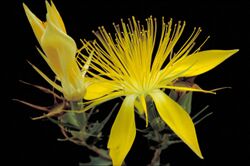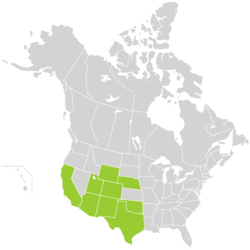Biology:Mentzelia multiflora
| Mentzelia multiflora | |
|---|---|

| |
| Adonis blazingstar | |
| Scientific classification | |
| Kingdom: | Plantae |
| Clade: | Tracheophytes |
| Clade: | Angiosperms |
| Clade: | Eudicots |
| Clade: | Asterids |
| Order: | Cornales |
| Family: | Loasaceae |
| Genus: | Mentzelia |
| Species: | M. multiflora
|
| Binomial name | |
| Mentzelia multiflora Nutt. & A. Gray
| |

| |
Mentzelia multiflora, commonly known as Adonis blazingstar, Adonis stickleaf, desert blazingstar, prairie stickleaf and manyflowered mentzelia is a herbaceous perennial wildflower of the family Loasaceae.
Distribution
Mentzelia multiflora is found in the western United States and northwestern Mexico: from Montana and North Dakota in the Great Plains; south to Texas and Southern California; and into Sonora and Chihuahua.[1]
This species prefers dry, sandy, well-drained soil. They require direct sunlight and are not found growing in the shade.[2]
Description
Mentzelia multiflora grows to about 2–2.5 feet (0.61–0.76 m) tall. It has shiny white stems and numerous branches. Its sticky, bright green leaves are covered with hairs containing minute barbs.
The flowers are around 5 cm (2.0 in) in diameter, are yellow in colour and normally have ten petals. The flowers open in late afternoon and close in the morning.[3][4] The flowers are hermaphrodite and flower from March to October.[1] The plant does not live for more than three yearsGrowth in selectively cut Ponderosa Pine forests of the Pacific Northwest - page 9.
Varieties
Varieties of Mentzelia multiflora include:
- Mentzelia multiflora var. integra — M.E. Jones
- Mentzelia multiflora var. longiloba — (J. Darl.) Kartesz [5][6][7]
- Mentzelia multiflora var. multiflora [8]
Taxonomy
Mentzelia multiflora was first described by the botanists Thomas Nuttall and Asa Gray. It is a "blazingstar" and is a member of the genus Mentzelia, the "stickleafs".[3][9]
Uses
- Medicinal
The plant is used by the Native Americans, particularly the Navajo people, as a medicinal plant.[10] It has been used to treat toothache and as a diuretic.[11][12] The roots and leaves have been used to treat tuberculosis.[2]
- Cultivation
The plant is cultivated as an ornamental plant, used as a wildflower in specialty gardens.[13]
References
- ↑ "ITIS Standard Report Page: Mentzelia multiflora". Itis.gov. https://www.itis.gov/servlet/SingleRpt/SingleRpt?search_topic=TSN&search_value=503788. Retrieved 2010-07-30.
- ↑ 2.0 2.1 ibiblio.org—pfaf: Mentzelia multiflora
- ↑ 3.0 3.1 "NPIN: Mentzelia multiflora (Adonis blazingstar)". Wildflower.org. 2010-05-28. http://www.wildflower.org/plants/result.php?id_plant=MEMU3. Retrieved 2010-07-30.
- ↑ "Vascular Plants of the Gila Wilderness- Mentzelia multiflora". Wnmu.edu. Archived from the original on 2010-05-28. https://web.archive.org/web/20100528002103/http://www.wnmu.edu/academic/nspages2/gilaflora/mentzelia_multiflora.html. Retrieved 2010-07-30.
- ↑ CalFlora: Mentzelia multiflora var. longiloba' . superseded in TJM2 by Mentzelia multiflora . accessed 10.1.2013
- ↑ "USDA Plants Profiles". Plants.usda.gov. 2010-07-26. http://plants.usda.gov. Retrieved 2010-07-30.
- ↑ Jepson
- ↑ CalFlora: Mentzelia multiflora var. multiflora
- ↑ "Centennial Museum and Gardens - Home". Museum.utep.edu. http://museum.utep.edu/chih/gardens/plants/GtoM/mentzeliamult.htm. Retrieved 2010-07-30.
- ↑ University of Michigan at Dearborn: Native American Ethnobotany of Mentzelia multiflora[yes|permanent dead link|dead link}}] . accessed 10.1.2013
- ↑ Moerman. D.; "Native American Ethnobotany" . Timber Press. Oregon 1998 ISBN:0-88192-453-9
- ↑ Whiting. A. F.; Ethnobotany of the Hopi" . North Arizona Society of Science and Art; 1939
- ↑ Huxley. A.; "The New RHS Dictionary of Gardening" . 1992. MacMillan Press 1992 ISBN:0-333-47494-5
External links
- Calflora Database: Mentzelia multiflora (Adonis blazingstar)
- Jepson Manual treatment for Mentzelia multiflora subsp. longiloba
Wikidata ☰ Q6817644 entry
 |

